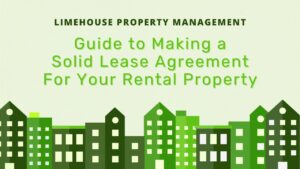Guide to Making a Solid Lease Agreement For Your Rental Property
Successful rentals have one thing in common: They have an effective lease agreement signed by a landlord and a tenant.
This contract ensures that both parties are in mutual agreement on the conditions and terms presented in the legal document. It’s also useful as a guide for property policies, conditions, responsibilities, and rights.
In this post, we are going over how to make a solid lease agreement for your rental property.
Defining a Lease
A lease is a contract containing specific policies, restrictions, and disclosures around the rental unit. It covers all the terms and conditions that tenants and landlords are lawfully mandated to comply with.
Leases commonly cover a rental term period of six months to one year.
Purpose of a Lease
Leases can be presented as proof in a courthouse. If you face a lawsuit, then the leasing agreement can be relied upon to help your case. If the lease agreement is done verbally with a tenant, then this can be challenging to prove in court.
For instance, if a tenant skips a rental payment and you don’t have a written lease, it’ll be difficult to deal with the situation because there’s no signed physical contract that exists between you and your tenant.
While you may not be having disputes in your tenant relationship at the moment, things can change, so it’s best to protect yourself. Having a solid leasing agreement helps clarify the conditions in your rental unit.
Although a lot of lease templates can be sourced from the Internet, it’s best to craft your own to make it more specific to your own rental’s needs.
Key Items to Include in a Leasing Agreement
1. Tenant & Landlord Names and Property Address
The full names of all parties, and the rental property’s name, must be written down in the leasing agreement. The property address must also be written, including the unit number if the unit you’re renting out is in an apartment building.
2. Rental Payment Due Date
To prevent confusion, it’s best to be specific about the rental payment dates in your leasing agreement. Writing it out in full (example: January 1, 2022) doesn’t leave room for any other interpretation and won’t allow renters to make an excuse for non-payment due to the confusing date.
3. Rental Amount
The amount of the rent must be written in words and figures to prevent misinterpretation. If other fees are collected, such as pet fees, then consider placing them under another category in the lease.
4. Rental Period
Write out the complete rental period in the agreement. For example, write “from January 1, 2022 to December 31, 2022.”
Writing something vague, such as “one year long,” can allow renters to overstay past the tenancy.
5. Signatures of all Parties
Ensure that the leasing agreement contains the signatures of both parties to show a full understanding of the terms and conditions of the contract.
Important Clauses and Policies to Cover in Your Lease
Though property policies can differ significantly from one rental unit to another, clauses tend to be similar since they are compliant with the State laws.
Here are clauses to add to your lease agreement:
1. Occupancy / Subletting
This outlines who is allowed to stay in the property and the acceptable length of time that guests are welcome to visit.
It also mentions if subletting is allowed. Subletting permits your renter to take in other renters and split the cost of the rent. You may allow your tenant to sublet, as long as proper written permission is sent to you first.
2. Tenant Rights and Responsibilities
Under this clause, you can state the duties of the renter to prevent property damage and to practice keeping a sanitary rental unit. You can also mention that the renters are required to maintain peace and quiet in the vicinity.
3. Landlord Rights and Responsibilities
Under this clause, you can mention the landlord’s responsibility to keep the rental unit in a livable condition. You can also include the duration of the repair when tenants submit a maintenance request.
4. Termination of the Lease
This clause provides information on penalties and the allowable period for early termination. It also specifies the justified reasons for renters to break a lease under the law.
The acceptable reasons are active military duty, being a victim of domestic violence, or being subjected to landlord harassment. If a landlord allows a tenant to break a lease early due to job relocation, then this should be clearly stated in the lease agreement.
5. Security Deposit
This clause details the amount of security deposit the landlord collects to encourage the renter to keep the rental unit free from damages. When the tenancy ends and damages beyond wear and tear occur, a landlord may deduct the repair charges from the security deposit.
You can include what counts as wear and tear and excessive property damage, so the renter can differentiate between them. Check to see the State law concerning the storage of the security deposit and be compliant with it. If the mandate is to keep the security deposit in an interest-earning account, then this must be practiced and mentioned in the agreement.
Ensure that the return of the security deposit is done according to the set number of days set by the State law. It’s important for the renters to know when they can be refunded their deposit.
6. Disclosures
These are state-required and must be found in the leasing agreement. Landlords must disclose the following to the renters: flood zone, bed bugs, radon, and lead-based paint.
Bottom Line
A leasing agreement guides the renters and limits conflicts between landlords and tenants.
At first, it may look complicated to create a lease, but learning what provisions, terms, and conditions to include can make the task easy.
It’s also crucial to be aware of the laws and regulations at the State and local levels to ensure compliance.
If you prefer having an expert property manager on-hand to provide this service, contact Limehouse Property Management today!





